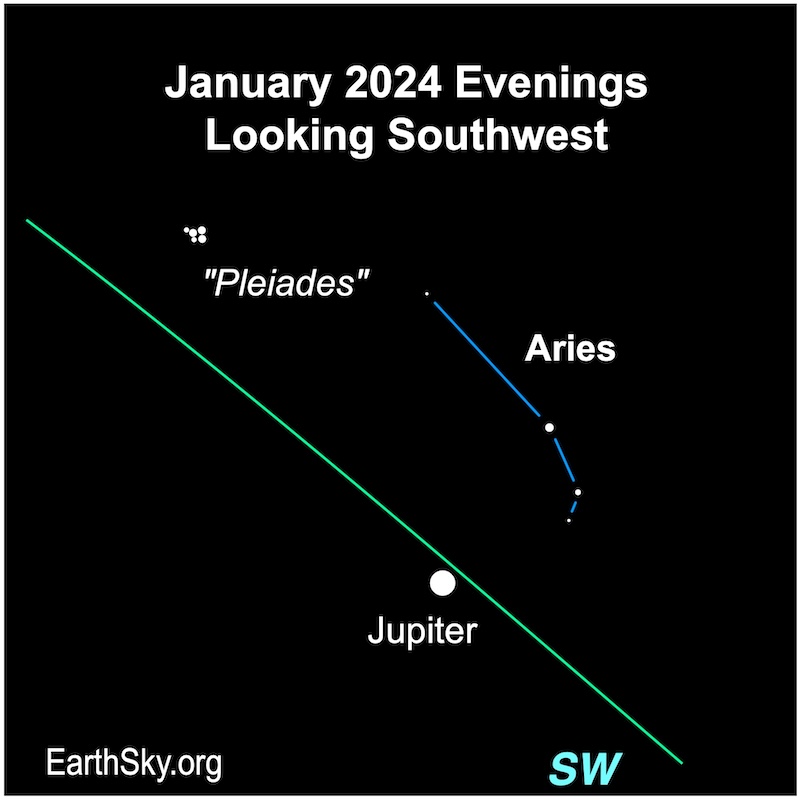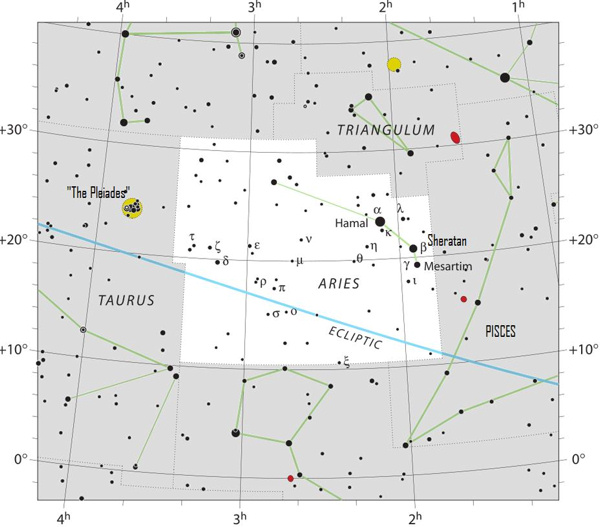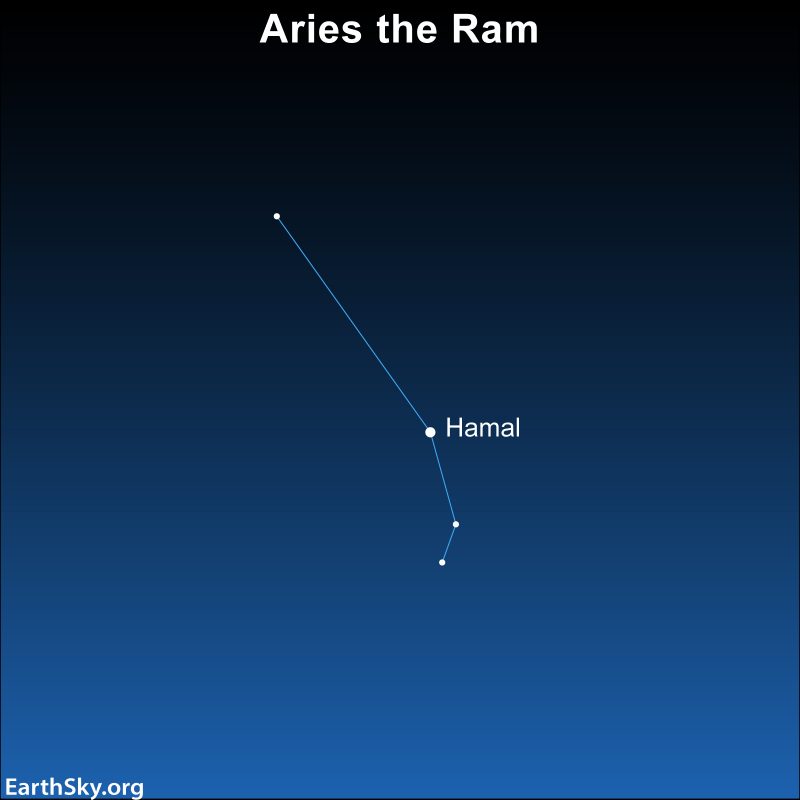
Aries the Ram isn’t a noticeable constellation. It ranks as the 11th smallest out of the 12 zodiacal constellations. And its stars are only moderately bright. But the giant planet Jupiter lies in front of Aries now. And December and January are great months to spot this faint constellation, with Jupiter’s help. Although Aries has few bright stars, there’s much to see telescopically within this constellation. And it figures prominently into the history of astronomy.
The 2024 lunar calendars are here! Best New Year’s gifts in the universe! Check ’em out here.

How to see Aries the Ram
The best time to behold the Mighty Ram is when the Earth is on the other side of the sun from this constellation. The months around the December solstice are especially good for viewing Aries the Ram in all his starlit majesty. During those months, this constellation shines above the eastern horizon at nightfall and stays out for most of the night. Aries culminates – reaches its highest point in the sky – at about 10 p.m. your local time in late November, 8 p.m. your local time in late December and 6 p.m. your local time in late January.
Because Aries isn’t a particularly prominent constellation, you’ll want a dark country sky, on a night when there’s no moon. The three stars depicting the Ram’s bust – Hamal, Sheratan and Mesartim – suddenly brighten in a dark sky. In fact, it’s as if someone had turned up the dimmer switch. By the way, a small telescope reveals that Mesartim is a double star.
Fortunately, the head of the Ram is fairly easy to locate. You’ll find it midway between these two signposts: the Pleiades star cluster to the east and the Great Square of Pegasus to the west. The Ram’s head is turned backward, as if admiring the Pleiades, or perhaps his own golden fleece.


What is the First Point of Aries?
The First Point of Aries marks the sun’s position in front of the constellations of the zodiac on the Northern Hemisphere’s spring equinox or Southern Hemisphere’s autumnal equinox. This equinox happens yearly on or near March 20, as the sun crosses the celestial equator, going from south to north.
Also, the First Point of Aries, which is actually in the constellation Pisces nowadays, defines the coordinate system on the celestial sphere. The First Point of Aries always coincides with zero degrees right ascension and zero degrees declination. Right ascension is the equivalent of longitude here on Earth. Declination on the sky’s dome is the equivalent of latitude.
In addition, the First Point of Aries is one of two places on the celestial sphere where the ecliptic and celestial equator intersect. Then the First Point of Libra resides 180 degrees east of the First Point of Aries, marking the September equinox point on the celestial sphere.

What is the First Point in Pisces?
Since the Earth’s rotational axis wobbles full circle relative to the backdrop stars in about 26,000 years, Polaris doesn’t remain the North Star forever. In turn, that means the equinox points don’t remain fixed relative to the stars of the zodiac. So, the March equinox point drifts westward (along the ecliptic) through the constellations of the zodiac at about one degree (two sun diameters) in 72 years, or 30 degrees in 2,160 years.
Hence, the March equinox point passed out of the constellation Aries and into the constellation Pisces in 68 B.C. Even so, we still call this equinox point the First Point of Aries.
Hamal, brightest star in Aries
Hamal, or Alpha Arietis, is the brightest star in Aries. This orange giant star shines at magnitude 2 and lies a bit more than 65 light-years from Earth.
In fact, Hamal means head of the ram, a fitting name. Also, sailors once used Hamal to help in navigation. And the star is the 50th brightest in the sky.
The celestial Ram in star lore
In Greek mythology, Aries represents the supernatural Ram that was sent by Zeus to rescue the children of Athamus, the King of Thebes, from political intrigue. Phrixus and his sister Helle were about to meet their demise, but the flying Ram, which could both speak and reason, took them away in the nick of time.
The children held on tight as the Ram flew them away for the safety of Colchis, an ancient kingdom bordering the eastern shore of the Black Sea. Unfortunately, Helle fell into the sea and drowned before reaching their destination. Hellespont – the ancient name for the Dardanelles Strait near Istanbul, Turkey – marks the place of her death, named in her honor.
Phrixus survived the long trip to Colchis. He gave thanks by sacrificing the Ram to Zeus, hanging it in a sacred grove where the fleece turned to gold. Later, Jason and the Argonauts recovered the Golden Fleece.

Bottom line: How to see the constellation Aries the Ram, plus info about this constellation in the history of astronomy and mythology.
All 12 (13) zodiac constellations
Taurus? Here’s your constellation
Gemini? Here’s your constellation
Cancer? Here’s your constellation
Leo? Here’s your constellation
Virgo? Here’s your constellation
Libra? Here’s your constellation
Scorpius? Here’s your contellation
Sagittarius? Here’s your constellation
Capricornus? Here’s your constellation
Aquarius? Here’s your constellation
Pisces? Here’s your constellation
Aries? Here’s your constellation











